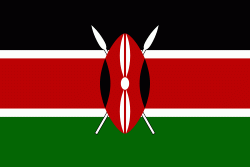Mbeere District (Mbeere District)
Mbeere District was a former administrative district in the Eastern Province of Kenya. Its capital town was Siakago. The district had a population of 170,950 and an area of 2,093 km2. The district was split from Embu District in 1996. In 2010, it was merged into Embu County.
The natives here, the Mbeere people, speak the Kimbeere language. There is also a large chunk of peoples from the Akamba community mainly concentrated in the southern parts of the former district.
The former district hosts the famous seven folks dams, which include: Masinga dam, Kamburu dam, Gitaru dam, Kindaruma dam and Kiambere dam which it shares with Machakos County. The dams are a part of Tana River. Other local places of interest include the Mwea National Reserve, and Kiangombe mountain, which peaked at 1804 metres stands out compared to adjacent topography, although is not as spectacular as the Mount Kenya located less than 100 kilometres northwest.
The dominant crops found there include fruits like mangoes, melons, pawpaws and passion fruits. The farmers in this area grow maize, beans, cowpeas, pigeon peas, black peas-njavi; others like millet are seasonally grown there. Mbeere district also came to be known with miraa, as it was the second largest producer after Meru. The miraa crop is commonly grown in what was the northern part of the district.
Mbeere district had only one local authority, Mbeere county council. The district had two constituencies: Siakago Constituency and Gachoka Constituency. The district was divided into four administrative divisions. More changes were expected with the split of the districts in year 2009; Mbeere South district whose headquarters is in Kiritiri town and Mbeere North district with headquarters in Siakago town.
Currently the constituencies have had their names changed from Gachoka to Mbeere South Constituency and from Siakago to Mbeere North Constituency.
The natives here, the Mbeere people, speak the Kimbeere language. There is also a large chunk of peoples from the Akamba community mainly concentrated in the southern parts of the former district.
The former district hosts the famous seven folks dams, which include: Masinga dam, Kamburu dam, Gitaru dam, Kindaruma dam and Kiambere dam which it shares with Machakos County. The dams are a part of Tana River. Other local places of interest include the Mwea National Reserve, and Kiangombe mountain, which peaked at 1804 metres stands out compared to adjacent topography, although is not as spectacular as the Mount Kenya located less than 100 kilometres northwest.
The dominant crops found there include fruits like mangoes, melons, pawpaws and passion fruits. The farmers in this area grow maize, beans, cowpeas, pigeon peas, black peas-njavi; others like millet are seasonally grown there. Mbeere district also came to be known with miraa, as it was the second largest producer after Meru. The miraa crop is commonly grown in what was the northern part of the district.
Mbeere district had only one local authority, Mbeere county council. The district had two constituencies: Siakago Constituency and Gachoka Constituency. The district was divided into four administrative divisions. More changes were expected with the split of the districts in year 2009; Mbeere South district whose headquarters is in Kiritiri town and Mbeere North district with headquarters in Siakago town.
Currently the constituencies have had their names changed from Gachoka to Mbeere South Constituency and from Siakago to Mbeere North Constituency.
Map - Mbeere District (Mbeere District)
Map
Country - Kenya
 |
 |
| Flag of Kenya | |
Kenya's earliest inhabitants were hunter-gatherers, like the present-day Hadza people. According to archaeological dating of associated artifacts and skeletal material, Cushitic speakers first settled in Kenya's lowlands between 3,200 and 1,300 BC, a phase known as the Lowland Savanna Pastoral Neolithic. Nilotic-speaking pastoralists (ancestral to Kenya's Nilotic speakers) began migrating from present-day South Sudan into Kenya around 500 BC. Bantu people settled at the coast and the interior between 250 BC and 500 AD. European contact began in 1500 AD with the Portuguese Empire, and effective colonisation of Kenya began in the 19th century during the European exploration of the interior. Modern-day Kenya emerged from a protectorate established by the British Empire in 1895 and the subsequent Kenya Colony, which began in 1920. Numerous disputes between the UK and the colony led to the Mau Mau revolution, which began in 1952, and the declaration of independence in 1963. After independence, Kenya remained a member of the Commonwealth of Nations. The current constitution was adopted in 2010 and replaced the 1963 independence constitution.
Currency / Language
| ISO | Currency | Symbol | Significant figures |
|---|---|---|---|
| KES | Kenyan shilling | Sh | 2 |
| ISO | Language |
|---|---|
| EN | English language |
| SW | Swahili language |















